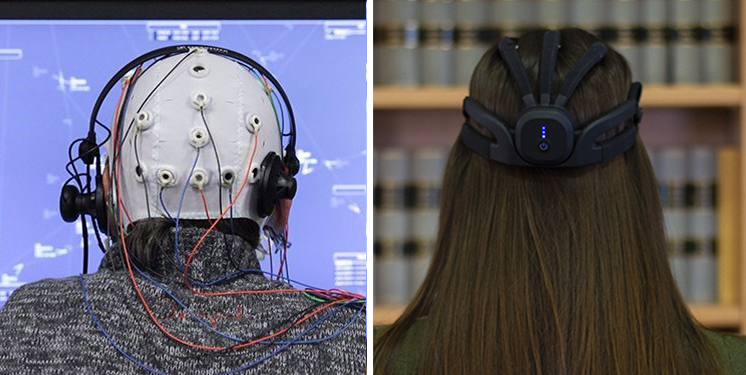Electroencephalography (EEG) is performed with the electroencephalograph, a non-invasive technology, that records the brain signals through the electrodes placed over the scalp thus suitable also for no-laboratory settings. It consists of a measurement method to detect the electrical activity of the brain.
Each conscious and unconscious mental function is the result of the electrical communication among the human brain neurons. Although it is not possible to record in a non-invasive way the electrical activity related to each neuron, the EEG technique is able to measure the voltage fluctuations over the scalp caused by the concomitant electrical activity of a neurons population. Such voltage fluctuations can be characterized in terms of time-domain characteristics (Evoked Potentials and Event-Related Potentials) or spectral content (EEG rhythms or bands).
The main EEG bands are the following:
- Delta (< 4 Hz) : delta activity is characterized by high amplitude and low frequency. Delta waves are associated with the onset of deep sleep stages in healthy adults.
- Theta (4-7 Hz): theta activity is important for the functions of learning and memory (Sammer et al 2007), concentration (Hagemann 2008) and control of attention (Kubota et al 2001; Smith et al 2001). This activity has been shown to increase with increasing cognitive task demands (mental workload).
- Alpha (8-12 Hz): alpha activity is found at the level of the visual cortex (occipital lobe) during periods of relaxation or idleness (eyes closed but awake). It is characterized by regular oscillations of high amplitude with a maximum on the parietal and occipital electrodes. It is inhibited during active tasks.
- Beta (13 -30 Hz): Beta activity is predominant when humans are awake. It is found in the frontal and central areas of the brain. This activity is associated with motor behaviour and it is generally attenuated during active movement. High beta band power is associated with increased concentration and states of alertness.
- Gamma (> 30 Hz): The gamma activity is the fastest in the EEG. Tallon-Baudry et al 2005 revealed that areas of the lateral occipital cortex play an important role in encoding visual stimuli and show large gamma oscillations differently influenced by attentional modulation. Recent studies reveal that gamma is related to many other cognitive functions such as attention, learning, memory (Jensen et al 2007) and language perception (Eulitz et al 1996).
The electrical activity of the brain (popularly known as "brain waves") recorded over specific areas of the scalp, under specific experimental conditions (e.g. an attention test), shows variations in terms of amplitude of oscillations in the above mentioned frequency bands. These variations can be associated to specific cognitive processes (e.g. memorization, decision making,…) and mental states (e.g. attention, workload, fatigue, drowsiness, …), validated in scientific literature.
In the context of brain activity evaluation the EEG, compared to the Computer Tomography (CT), is relatively inexpensive and no-bulky and, when compared to the Magnetic Resonance Imaging (MRI) it offers a higher temporal resolution (milliseconds) to follow the brain processes that is not possible using CT or MRI devices.
EEG in medical field is often used to diagnose epilepsy, which causes abnormalities in EEG waves. It is also used to diagnose sleep disorders, coma, encephalopathies and brain death. Generally the EEG technology is used as a first-line method in clinical applications about the human brain health, thanks to its safety and non-invasiveness for the patient.
Over the past 15 years the benefits of EEG technology have led to its widespread use in neuroscience, cognitive psychology, psychophysiological and neuroergonomic research, in addition to clinical applications.
BrainSigns uses EEG to evaluate different mental states related to attention, memorization, cognitive workload, mental fatigue, stress, pleasantness.









